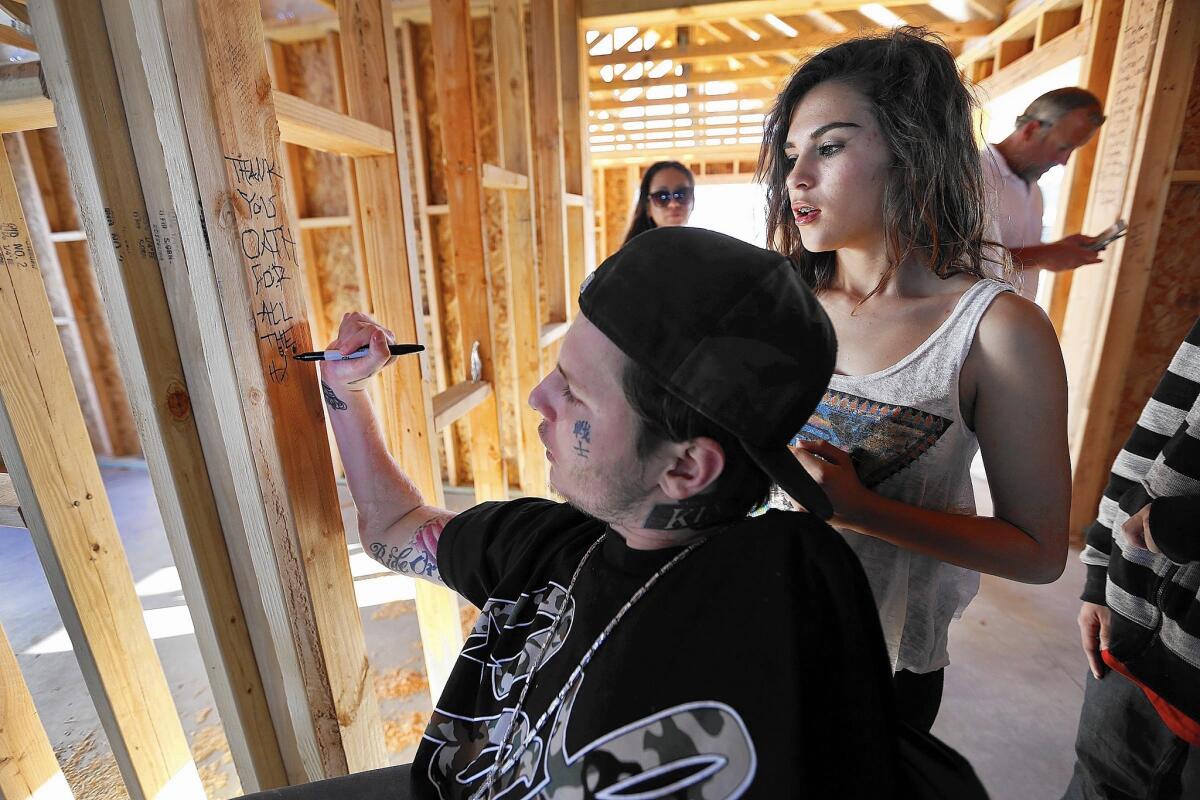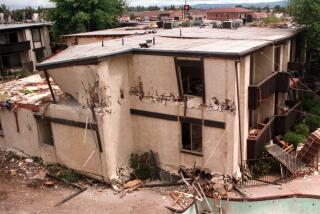Great Read: Inspired by paralyzed Army vet, Lancaster students build him a new home

Iraq war veteran Jerral Hancock writes a thank-you note to the Lancaster High School students who raised money to build him a new, handicapped-accessible home. Behind Jerral is his sister Savannah Tscherny, 15
Jerral Hancock is trying to squeeze into his 8-year-old daughter’s bedroom, but his electric wheelchair won’t fit through the doorway.
The door frames and walls are scuffed and scratched from his chair trying to make the tight spaces in the Lancaster mobile home. He gives up and backs away slowly, rubber wheels bumping against the wall. Eleven-year-old Julius’ toy-cluttered bedroom sits catty-corner to Anastasia’s. He doesn’t even try to go in there.
“This isn’t what I saw myself coming home to when I was out there, I can tell you that,” Hancock says, his voice husky.
------------
FOR THE RECORD:
Iraq war veteran: In the June 11 Section A, an article about a high school class that launched a drive to build a home for a disabled Iraq war veteran referred incompletely to the role played by others in the project. In addition to staging a benefit concert, the Gary Sinise Foundation managed the project along with the students. By the project’s conclusion, the majority of funds to build the two houses had been raised by the Sinise foundation with the support of multiple donors and partners, including the Carrington Development Co., the Independence Fund and Disabled American Veterans. —
------------
Eight years ago, Hancock was a specialist with the Army’s 1st Cavalry Division. He was driving an M1 Abrams tank outside Baghdad when it hit a roadside bomb that pierced the 70-ton vehicle’s steel armor.
Shrapnel wedged into his spine, paralyzing him from the chest down. Flames “cooked off” his left arm, the one with the Los Angeles Dodgers tattoo, and it would have to be amputated at the shoulder.
It was May 29, 2007 — his 21st birthday.
Anastasia, a charmer with her daddy’s brown eyes, was born three weeks before the blast. The first time Hancock met the “baby of the burn unit,” he was propped up in a hospital bed, pale and skinny, covered in burn wraps.
Anastasia slips into the living room as Hancock tells the story. She’s all blond hair and sass, an extrovert who grew up in hospital waiting rooms cheering up adults.
She puts her head on her dad’s chest and wraps her arms around his shirtless, scarred torso.
::
In her classroom at Lancaster High School, Jamie Goodreau tries to teach her students that history is a living thing, that they can be part of it.
A soft-spoken woman with kind eyes and a big smile, Goodreau requires her students to create projects that give back to the community. One year, they organized a 1940s-style airport hangar dance, hired a swing band and raised more than $10,000 to restore a World War II B-17 bomber.
When her students found out the Antelope Valley had no Armed Forces Day celebration, they created one. For more than a decade, they’ve hosted an annual dinner called Pride of the Nation. It was there, in 2013, that they met Hancock and his children.
Hancock had been given a hero’s welcome when he came home wounded. He was grand marshal of the Veterans Day parade. Lancaster hung a light-pole banner with his photo under the words “Hometown Hero.” But privately, he was struggling.
He came to speak to Goodreau’s history class, on his 27th birthday, and opened up about his life after war. There was the physical agony. The nightmares about burning in that tank. The post-traumatic stress disorder playing out in a noisy mobile home park.
Hancock’s wife left him and the kids. His mother and stepfather became his full-time caretakers, living across the street. Sometimes, when he forgot to ask someone to turn the lights off before bed, he’d just sleep with the lights on, too embarrassed and angry to have to call his parents or wake the kids to turn them off for him.
Hancock wasn’t much older than the students, who were stunned by his struggles.
“It broke my heart inside,” student Nicole Skinner said. “I thought I knew war was bad, but wow.”
The students wanted to help. So, the next day, with a quick classroom vote, they made a radical decision: They were going to build Hancock a new house.
::
Goodreau’s students dubbed themselves OATH — Operation All The Way Home. They spent the summer hawking dog tags, T-shirts, coffee mugs. They passed donation buckets at Lancaster Jethawks baseball games and formed “bucket brigades” outside Wal-Mart. They had pizza nights, flapjack fundraisers, yard sales.
Pretty soon, people all over the Antelope Valley “took the OATH.” Inmates at the California State Prison in Lancaster even chipped in with an art fundraiser, selling paintings and handmade jewelry. After word got out about what the students were doing and how much they had already raised, actor Gary Sinise and his Lt. Dan Band put on a benefit concert in Lancaster.
OATH raised $170,000 in under a year; by the end of the second year, more than $350,000 in cash had been raised. A three-acre property in Palmdale was bought, on a quiet lot on a dirt road, with mountain views and big Joshua trees.
The real estate agent waived her commission. Local architects drew up the blueprints for free and taught the teens how to go about building a house, how to take bids on the work, how to take out a mortgage. Ten months after Hancock spoke to the class, Goodreau’s white Dodge pickup truck pulled up to the Los Angeles County Building and Safety office in Lancaster, and teenagers piled out of the back seat. It was time to get a construction permit for Hancock’s house.
Goodreau — whom the kids call Mama G — herded the teenagers into the quiet, white-tiled county office.
“Inside voices!” she yelled, grinning. “Sorry, we’re excited,” she whispered apologetically to a county staffer caught off-guard by the rowdy group in jeans and sneakers. “I’ll be like a crazy mom, taking pictures.”
::
This title of town hero has been an awkward fit for a quiet, sardonic soldier who has spent the years since his injury getting tattoos over his scars. A tank on his chest. A flaming Purple Heart on his neck. The Japanese symbol for warrior on his cheek. The words “Ride or Die” on his right arm, which was left so weak he can’t drink a bottle of water without someone lifting it to his mouth.
The kids raising the money should be getting the praise, he says, not him.
“I’m not big on being in the spotlight,” he says, a few months after the project began. Strangers have started coming up to him in public, thanking him for his service, giving him fist bumps on his weak right hand. They quietly hand him cash, apologizing if they missed OATH events. He feels guilty when he’s down, with all they’re doing for him.
A few days after the students get the building permits, Hancock is in his home, where there are photos everywhere of the baby-faced soldier in his Army fatigues: hair cropped, smoking a cigarette in the desert, mugging for the camera with the unmistakable swagger of a teenage soldier. He was 18 when he joined the Army. He’d tested out of high school, smart but bored, and become a father.
“I was trying to figure something out, working part time and sleeping on my mom’s floor with a kid,” he says. “I felt like a bum.” A buddy called and said he was joining the Army. Hancock went to a recruiter the next week. He wanted something better for his son, and this was his chance.
::
On May 6, 2014, the students break ground on the property, where they’re also building a house for Hancock’s mom and stepfather, Stacie and Dirrick Benjamin. It’s a community celebration: dozens of residents, young and old, some of them clutching American flags.
An older man spots Hancock and grins.
“Jerral, brother, how are you, sir?”
“Still breathing. Can’t complain.”
Goodreau is emotional as the crowd grows. “What a journey,” she says into a microphone on a stage set up between two construction trucks. The students “were determined to run a marathon at sprint speed because Jerral had been in that house for six years, and they thought six years was too long.”
Kaelynn Edwards, 17, smiles at Hancock from the microphone.
“We gave up the summer of our senior year,” she says, “but Jerral’s sacrifice was bigger.”
::
By this February, the wooden frames of the two houses stand tall. There are construction workers on site — they’ve been working weekends and nights, with lights strapped to their heads — and sawdust on the floor as the students step inside Hancock’s house. They’re armed with markers to sign the bare plywood. Their messages will be painted over, but their words will remain there forever.
Goodreau signs the top of a window frame, the words of “Amazing Grace”: “Tis grace that brought me safe thus far, and grace will lead me home.”
When Nicole Skinner, who is now in college, sees how far the house has come, tears run down her face.
“This is going to be a real house,” she whispers. “Like, who does that but us?”
She’s grown close to Hancock in the nearly two years since he spoke to her class. A shy foster child with a tough upbringing, she has come to consider her fellow OATH students and Hancock her family.
In purple marker, she writes on Hancock’s wall: “You deserve this, Hancock! ... It’s a simple act of kindness that can make a difference. Keep your head up, J.”
As the house has raised, so have Hancock’s spirits. He’s seen the students grow, and he tells them often he’s proud of them.
He’s also fallen in love. Adriana Gonzalez, a military daughter with a sarcastic sense of humor on par with his, came to many of the OATH events, where they talked and talked. Last fall, he proposed. She said yes.
They move quietly through the house, reading the students’ messages, sunlight streaming through the wooden framing. She puts her hand on his shoulder.
::
Disabled veterans call the day they survive their injuries their Alive Day. On his latest Alive Day — and his 29th birthday — Jerral Hancock goes home.
His family pulls onto the property, escorted by sheriff’s deputies and flag-bearing Patriot Guard motorcycle riders. Dozens of people line the driveway, cheering in the hot desert sun.
A white-haired Navy veteran leads the crowd in prayer: “Bless these houses and put lots of love in them, so they’ll turn into homes.” Someone holds up the infant son of the local contractor who led construction — he’s wearing a camouflage OATH onesie.
Hancock’s new handicap-accessible house has automatic doors, lights and blinds that can be controlled with a tablet computer — and wide doorways.
He steers his chair into his son’s Army-green bedroom, where Julius waves to him with both arms from the top of his new bunk bed.
“Look, I’m a private!” Julius says, mimicking a soldier.
Anastasia runs into her bright blue bedroom, and jumps on her new bed, with its Disney “Frozen” bedspread. She’s so excited: In the past, whenever she wanted to hear a bedtime story, she’d go to her dad’s room, listen to the story, and return to hers to go to sleep.
Now, her dad will be able to read her stories in her own bedroom.
More to Read
Sign up for Essential California
The most important California stories and recommendations in your inbox every morning.
You may occasionally receive promotional content from the Los Angeles Times.











